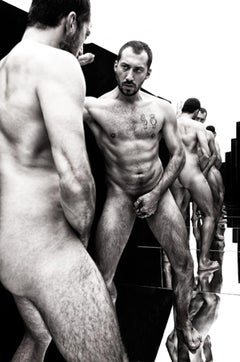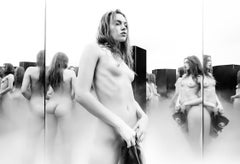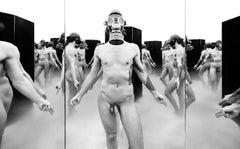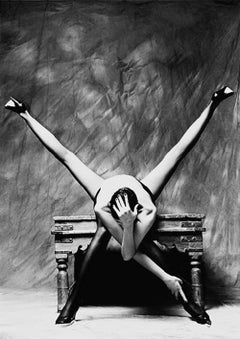Koray Erkaya Black and White Photography
Koray Erkaya, born in Turkey in 1964, is a photographer and author based in Toronto, Canada. He began his career working as a fashion and advertising photographer for magazines, advertising agencies and clients. In May 2010, he was invited as an honored guest to take part in a photo exhibition in the “Festival Européen de la photo de Nu” with the Don’t Tell Mamma series. After 2010, Erkaya became more interested in fine art photography and started to work on themed projects that he creates through nude photography. After the silent and peaceful protest in Istanbul Gezi Park in 2013, he prepared the photography exhibition “Invacuo” emphasizing the heavy use of tear gas on innocent protestors. The book with the same name was published in the same year. Erkaya has opened 7 solo and 34 combined exhibitions worldwide. Among his well-known series are, Don’t Tell Mama, Self Touches, Invacuo and TooLess. Now, he focuses on creating installations such as special 3D frames and infinity mirror installations. Erkaya is a member of AIAP (Association International des Arts Plastique) and an accredited photographer from PPOC (Professional Photographers of Canada).
2010s Contemporary Koray Erkaya Black and White Photography
Archival Pigment
2010s Contemporary Koray Erkaya Black and White Photography
Metal
2010s Contemporary Koray Erkaya Black and White Photography
Archival Pigment, Black and White
2010s Contemporary Koray Erkaya Black and White Photography
Black and White, Archival Pigment
2010s Contemporary Koray Erkaya Black and White Photography
Archival Pigment, Black and White
2010s Contemporary Koray Erkaya Black and White Photography
Archival Pigment, C Print
2010s Contemporary Koray Erkaya Black and White Photography
Black and White, Inkjet, Archival Pigment
2010s Contemporary Koray Erkaya Black and White Photography
Black and White, Archival Pigment
2010s Contemporary Koray Erkaya Black and White Photography
Black and White, Archival Pigment
2010s Contemporary Koray Erkaya Black and White Photography
Archival Pigment, C Print
2010s Contemporary Koray Erkaya Black and White Photography
Black and White, Archival Pigment
2010s Contemporary Koray Erkaya Black and White Photography
Archival Pigment, Black and White
2010s Contemporary Koray Erkaya Black and White Photography
Archival Pigment, Black and White
2010s Contemporary Koray Erkaya Black and White Photography
Archival Pigment, C Print
2010s Contemporary Koray Erkaya Black and White Photography
Archival Pigment, Black and White
2010s Contemporary Koray Erkaya Black and White Photography
Black and White, Archival Pigment
2010s Contemporary Koray Erkaya Black and White Photography
Black and White, Archival Pigment
2010s Contemporary Koray Erkaya Black and White Photography
Black and White, Archival Pigment
2010s Contemporary Koray Erkaya Black and White Photography
Archival Pigment, Black and White
2010s Contemporary Koray Erkaya Black and White Photography
Black and White, Archival Pigment
2010s Contemporary Koray Erkaya Black and White Photography
Archival Pigment, C Print
2010s Contemporary Koray Erkaya Black and White Photography
Black and White, Archival Pigment
2010s Contemporary Koray Erkaya Black and White Photography
Black and White, Archival Pigment
2010s Contemporary Koray Erkaya Black and White Photography
Black and White, Archival Pigment
2010s Contemporary Koray Erkaya Black and White Photography
Black and White, Archival Pigment
2010s Contemporary Koray Erkaya Black and White Photography
Black and White, Archival Pigment
2010s Contemporary Koray Erkaya Black and White Photography
Black and White, Archival Pigment
1990s Contemporary Koray Erkaya Black and White Photography
Archival Pigment, Black and White
1990s Contemporary Koray Erkaya Black and White Photography
Black and White, Archival Pigment
2010s Contemporary Koray Erkaya Black and White Photography
Black and White, Archival Pigment
2010s Conceptual Koray Erkaya Black and White Photography
Archival Pigment, C Print
2010s Contemporary Koray Erkaya Black and White Photography
Archival Pigment, Black and White
2010s Contemporary Koray Erkaya Black and White Photography
Black and White, Archival Pigment
2010s Contemporary Koray Erkaya Black and White Photography
C Print, Archival Pigment
2010s Contemporary Koray Erkaya Black and White Photography
Archival Pigment, Black and White
2010s Contemporary Koray Erkaya Black and White Photography
Archival Pigment, Black and White
2010s Conceptual Koray Erkaya Black and White Photography
Archival Pigment, C Print





